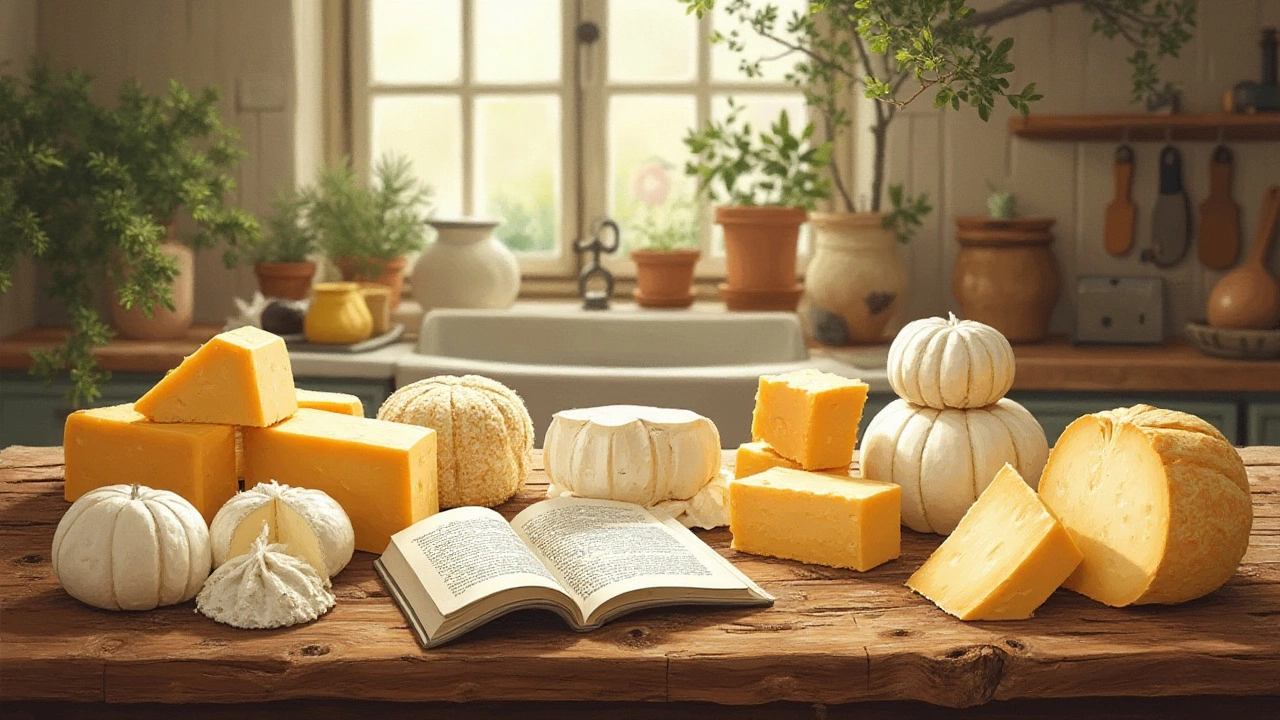
When it comes to cheese, mozzarella holds a special place in many hearts and kitchens. Yet despite its popularity, many are still confused by the variations that exist under this familiar name. In the culinary world, such subtleties matter—and understanding them can elevate your cooking game significantly.
Whether you're savoring a slice of pizza or crafting a tiramisu, knowing which type of mozzarella to use can make a world of difference. Let's dive into what sets these cheeses apart and how you can use each to create mouthwatering dishes.
- Different Types of Mozzarella
- Origins and Varieties
- Mozzarella in Tiramisu
- Texture and Flavor Profile
- Tips for Best Use
Different Types of Mozzarella
When talking about cheese varieties, it's fascinating just how many options exist within the category that we commonly refer to as mozzarella. Let's start with the traditional buffalo mozzarella, known in Italy as "mozzarella di bufala." It's made from the milk of the domestic water buffalo and boasts a rich, creamy texture with a slightly tangy flavor profile. This cheese is prized for its moisture content, making it ideal for fresh dishes where its delicate taste can shine. It is important to note that this cheese does not melt as well as others, making it a less optimal choice for pizzas but perfect for salads like Caprese.
Then we have the cow's milk version, often found under the name "fior di latte." It's somewhat firmer than buffalo mozzarella and doesn't have quite the same punch of flavor, but it compensates by being more versatile, especially in cooked dishes. It's the go-to mozzarella when making traditional Neapolitan pizza, loved for its ability to melt beautifully and create that gooey consistency we all cherish. In fact, the use of fior di latte is so integral to authentic Neapolitan pizza, the Associazione Verace Pizza Napoletana includes it in their strict ingredient list for a true Neapolitan pizza.
According to cheese expert and author Laura Werlin, "Each type of mozzarella has its own personality, much like wine. You savor its qualities differently depending on how it's used."
A relative newcomer to the mozzarella family is smoked mozzarella, or "scamorza." It's hung and smoked, resulting in a bolder, more dynamic flavor. Scamorza is excellent both fresh and melted, often enhancing pasta bakes or grilled sandwiches with its savory and smoky qualities. Interestingly, its robust flavor means it can be paired with both savory and sweet elements, adding an unexpected twist to any dish.
For those looking to match unique textures, there's burrata, which takes mozzarella to new, creamier heights. It's essentially mozzarella filled with a soft, buttery filling, often crafted from stracciatella and cream. This cheese is best enjoyed fresh, where the contrast between its solid exterior and creamy interior can be fully appreciated. In upscale restaurants, chefs might serve burrata with fresh produce and olive oil to allow its quality to shine through.
Summary of Mozzarella Types
- Buffalo mozzarella: Rich and creamy with a tangy flavor. Best for fresh dishes.
- Fior di latte: Versatile cow's milk mozzarella, perfect for pizzas.
- Scamorza: Smoked variety, adds complexity to cooked dishes.
- Burrata: Creamy center, ideal for fresh, simple presentations.
Understanding these different types not only enriches your palate but also your culinary creations. Whether crafting a classic pizza or an inventive tiramisu, choosing the right mozzarella makes all the difference.
Origins and Varieties
Mozzarella, with its creamy texture and mild flavor, is a beloved cheese that has captured the hearts of food enthusiasts globally. Its roots can be traced back to Italy, particularly the regions of Campania and Calabria, where traditional mozzarella is often made from the milk of water buffaloes. Known as Mozzarella di Bufala, this version boasts a richer taste and softer texture, revered by cheese connoisseurs all around the world. Yet, as the popularity of this cheese spread beyond the Italian borders, various adaptations began to emerge.
The most common type of mozzarella found internationally is made from cow's milk, known simply as Fior di Latte. This variant is more accessible and offers a slightly firmer texture compared to the buffalo milk version. Many believe that the flavor profile of cow's milk mozzarella is subtler, making it a versatile choice for a range of dishes, from pizza to salads. Intriguingly, the production processes for these cheeses have adapted over time, employing both traditional techniques and modern innovations to preserve their beloved qualities.
Beyond these classics, mozzarella has various other forms. Smoked mozzarella, or Scamorza, is a delightful twist that involves the cheese being smoked during its creation, imparting a golden color and a distinct smoky flavor. On the other hand, Burrata—a cousin of mozzarella—features a soft shell encasing a creamy interior, adding a luxurious touch to any meal. As preferences evolve, so do the methods of creating exceptional mozzarella varieties, each bringing something unique to the table.
Maurizio Inserra, a respected Italian cheesemaker, once said, "There's a magic in mozzarella that transcends its simple ingredients, transforming milk into something much more than just a cheese."
Each variety of mozzarella has its own loyal following, and selecting the right type for your dish can influence its outcome greatly. For instance, the choice of a buffalo versus a cow's milk cheese can alter the texture and flavor of a dish significantly. Ethereal in its simplicity, mozzarella's journey from the pastures of Italy to global kitchens marks its importance in the gastronomic world, showcasing not only its adaptability but also its indispensable role in both traditional and contemporary culinary arts.

Mozzarella in Tiramisu
To the uninitiated, the harmonious marriage of tiramisu and mozzarella might seem just as improbable as a square wheel. But for culinary explorers, this pairing offers an unexpected adventure that tickles and tantalizes the taste buds. Although mozzarella is not traditionally associated with desserts, innovative chefs have begun experimenting with softer, creamier versions of this cheese variety to add a surprising twist to the classic dish of tiramisu. Such creativity breathes new life into established recipes, showing just how versatile mozzarella can really be.
While traditional tiramisu relies heavily on mascarpone for its creamy texture, swapping in mozzarella can create a firmer structure while still maintaining that creamy, melt-in-your-mouth experience. One might wonder why the flavor of mozzarella, which is mild yet distinct, works well with the coffee and cocoa notes known to tiramisu. The answer lies in mozzarella's ability to complement rather than overpower. This quality allows it to blend with the layers of ladyfingers soaked in espresso, enhancing rather than competing with them.
Choosing the Right Mozzarella
Not just any mozzarella will do when creating tiramisu. Opt for a fresh or buffalo mozzarella, known for its soft texture and creamy consistency. These types ensure that the dessert retains its characteristic richness without becoming overly compact. When incorporated correctly, they add a hint of savoriness, which unexpected guests might mistake for some secret ingredient, contributing to the dish's allure.
In Italy, one of the die-hard bastions of traditional tiramisu crafting, chefs have already begun incorporating these cheese varieties. Their efforts were met with pleasant surprise, marking the beginning of a small culinary revolution. "The magic is in finding balance," says famed Italian chef Giuseppe Ruggeri, "Mozzarella provides that balance through its subtle flavor."
Of course, making tiramisu with mozzarella requires a bit of finesse and willingness to break from longstanding norms. Begin by melting and blending the mozzarella until smooth and fold it gently into a mix of whipped cream to introduce airiness. It's essential to maintain the characteristic layers of tiramisu, yet don’t shy away from intertwining textures. Though unconventional, those brave enough to try will find themselves on a deliciously curious journey, showcasing how the simplicity of mozzarella can integrate into elaborate, celebratory desserts.
Texture and Flavor Profile
Mozzarella cheese, with its distinct textures and flavors, offers a versatile option for countless culinary creations. However, it’s crucial to recognize that not all mozzarella types are created equal. Take the traditional Buffalo Mozzarella, for instance. This soft cheese, made from the milk of water buffalo, is cherished for its delicate and creamy texture that practically melts on the tongue. Its mild yet slightly tangy flavor profile makes it a dreamy addition to any dish where cheese takes center stage. Curiously, the production process plays a significant role in shaping these attributes, with the rich, fatty milk of the buffalo contributing to its creamy disposition.
In contrast, the more commonly available Cow's Milk Mozzarella presents a firmer structure and a milder taste. It holds up well under heat, making it an ideal candidate for pizzas and bakes where you want to preserve some chew. The stretchiness of this variant is iconic, providing not just flavor but an interactive culinary experience that both novices and experts can appreciate. According to the well-regarded cheese expert, Janet Fletcher, "Mozzarella's texture impacts not just how it tastes, but how it feels—a crucial element in shaping the eating experience."
Another variety to note is the low-moisture shredded mozzarella often used in commercial food preparation. This cheese, extensively found in supermarkets, has a more pronounced salty taste due to the reduced moisture content, and it lacks the fresh creaminess of its traditional counterparts. While convenient, it doesn’t quite deliver on flavor and texture when eaten raw but works brilliantly in melty dishes where it integrates with other ingredients. The choice between these varieties hinges on the recipe and desired outcome, with each offering unique benefits. A key aspect to consider is that mozzarella's mild base makes it a perfect canvas for complementary flavors within dishes such as tiramisu, where it can absorb and highlight various other ingredients.
As we delve deeper, the nuances of these cheeses become more apparent. The distinctions in flavor, be it sweet, milky, or slightly acidic, along with variations in texture, from a smooth and silky feel to a more solid and compact bite, underscore the importance of selecting the right mozzarella for the recipe at hand. Harnessing these differences not only elevates the dish but encourages an explorative approach to cooking, offering endless possibilities and combinations.

Tips for Best Use
Choosing the right type of mozzarella for a dish isn't just about picking something that melts well. It's about balancing textures, flavors, and the intended culinary experience. Fresh mozzarella, for instance, often showcases in summer salads, like Caprese, where its delicate texture complements the juicy tomatoes and the fragrant basil. This variant is known for its high moisture content, making it softer and more prone to leaking liquid over time, which is why it isn't ideal for cooking pizzas, as the excess water can make the crust soggy.
For cooking purposes, particularly when a melty finish is desired, low-moisture mozzarella reigns supreme. This variety melts beautifully, browns nicely, and is less likely to make your dish watery. When preparing a lasagna, a mix of low-moisture mozzarella and ricotta creates a creamy, yet structured layering that holds the dish together. Enhancing the umami flavors with some grated Parmesan cheese can multiply the rich cheesiness, perfect for cheese lovers.
“Using the right mozzarella can transform your dish from something ordinary to extraordinary,” says Maria Loretti, a culinary instructor known for her classes on Italian cuisine in Rome.
When incorporating mozzarella into a dessert like tiramisu, it's critical to understand that while traditional recipes do not call for mozzarella, variations in texture and creativity can inspire chefs. Although uncommon, the use of cheese with milkier tastes can enhance the richness of a tiramisu, offering an interesting twist to classic recipes. In these cases, subtle cheese notes should complement the heavy creams and aromatic coffee.
Storing Mozzarella
Proper storage is essential to maintain the quality of any type of mozzarella. Fresh mozzarella should be kept in its brine and consumed within a few days. For prolonged storage, considering vacuum-sealing can help maintain its freshness. Low-moisture mozzarella, on the other hand, has a much longer shelf life, often lasting weeks in the refrigerator without the loss of quality. When storing, it's important to wrap it tightly in plastic wrap to prevent it from drying out. These practices ensure you get the most out of your cheese until its last shred.
To make the most of these tips, consider a practical experiment in your kitchen. Try preparing the same dish using different types of mozzarella. One can make a pizza with fresh mozzarella one day and the next with low-moisture mozzarella. Observe the changes in texture and flavor. Not only will this deepen your appreciation for cheese varieties, but it might also give you a new perspective on your favorite dishes. By recognizing the importance of choosing the right mozzarella, your cooking can do wonders, showcasing the best of what these cheeses have to offer.